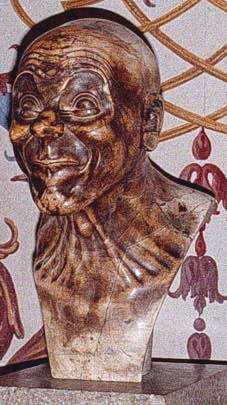The Simpleton (Messerschmidt)
| The Simpleton | |
|---|---|
| German: Der Schaafkopf | |
 | |
| Artist | Franz Xaver Messerschmidt |
| Year | 1777 - 1783 |
| Medium | alabaster |
| Dimensions | 43 cm × 23 cm × 32 cm (17 in × 9.1 in × 13 in) |
| Location | Österreichische Galerie Belvedere, Vienna |
The Simpleton (German: Der Schaafkopf) is a sculpture bust by Franz Xaver Messerschmidt, one of the Character Heads.
Description
The sculptures dimensions are 43 × 23 × 32 centimeters.[1] It is in the collection of the Österreichische Galerie Belvedere, in Vienna.[2]
Analysis
The bust is one 64 "canonical grimaces" of the human face using himself as a model.
In 1781, German author Friedrich Nicolai visited Messerschmidt at his studio in Pressburg and subsequently published a transcript of their conversation. It appears that for many years Messerschmidt had been suffering from an undiagnosed digestive complaint, now believed to be Crohn's disease, which caused him considerable discomfort. In order to focus his thoughts away from his condition, Messerschmidt devised a series of pinches he administered to his right lower rib. Observing the resulting facial expressions in a mirror, Messerschmidt then set about recording them in marble and bronze.
References
- ↑ "Der Schaafkopf | Franz Xaver Messerschmidt - Europeana". Europeana.eu. Retrieved 2016-09-27.
- ↑ "Der Schaafkopf – Werke – Digitales Belvedere". Digital.belvedere.at. 2016-07-14. Retrieved 2016-09-27.
External links
-
 Media related to Character head No. 17 (The Simpleton) at Wikimedia Commons
Media related to Character head No. 17 (The Simpleton) at Wikimedia Commons